Are you looking to get into teaching preschool piano? In this article, I’m going to give you a quick crash course on what you need to know to get started.
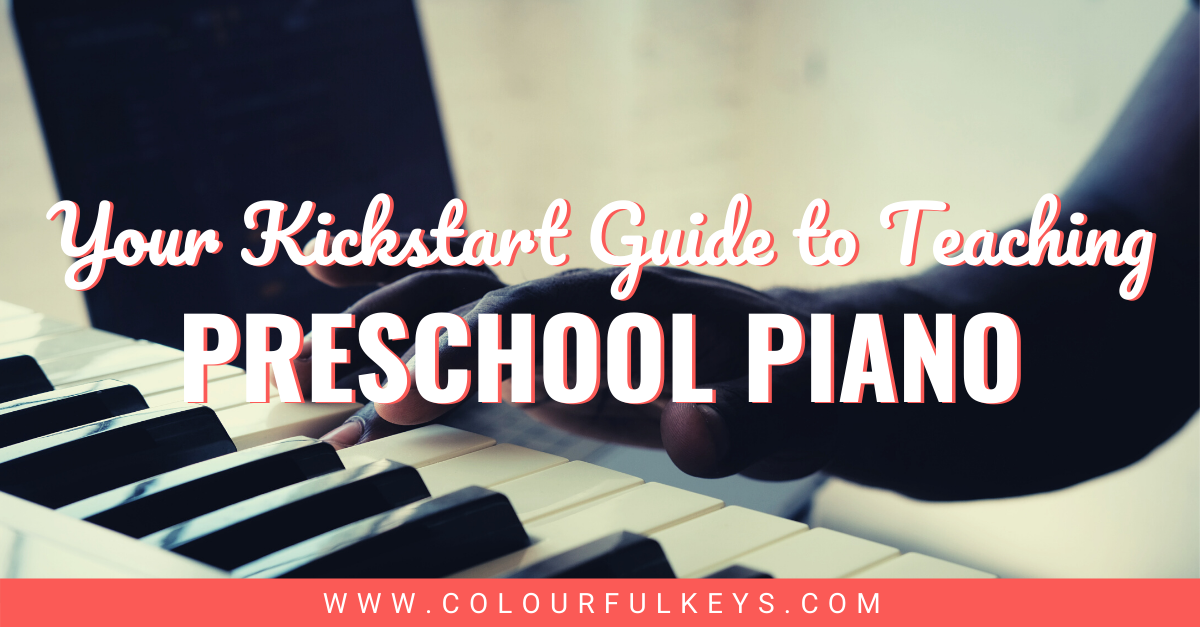
Of course, it’s hard to cover absolutely everything you need to teach preschool piano successfully in the scope of one article. If there’s something here that you want to dive into further you can find all you need to know in my book, ‘Playful Preschool Piano Teaching’.
Choose Between Group and Private
The first decision you’ll need to make is whether to teach group preschool classes or one-on-one lessons…or both.
Personally, I see the benefits of both formats for different kids and family circumstances, so I offer a choice in my studio.
Benefits of Private Lessons for Preschoolers
Many piano teachers gravitate instinctively towards the idea of teaching piano to preschoolers in a private or one-on-one format because it seems more familiar.
Since most teachers already teach individual lessons to older students, this seems like a gentle and comfortable way into teaching these tiny ones.
But don’t be fooled.
Even if you opt to teach one-on-one preschool lessons, they are not going to be anything like your lessons with older students. Preschoolers are not just miniature 7-year-olds. They are in a completely different developmental stage and need to learn differently.

There are still benefits of teaching individual lessons for preschoolers though. If you have a tight teaching space it may not be feasible to fit a group, and you may just prefer to work with one student at a time based on your personality and communication style.
For the preschooler themselves, the benefit is of course the individual attention they will receive. For particularly focussed students and kids with a lot of support at home this can be fantastic.
Benefits of Group Lessons for Preschoolers
My Mini Musicians program is for small groups of 4–8 students and I find this to be a great fit for most preschool-aged students. Group classes lend themselves well to lots of movement, singing and improvisation which is exactly what little kids need.
I don’t require any practice at all from my Mini Musicians students. This works very well for families who want their kiddo to have music in their life but aren’t ready to sit with them during daily practice yet.
Group lessons are also beneficial for you as a business owner as you have the opportunity to make a little bit extra from those classes. (Check back on the blog next week for the release of our group lesson rate calculators to see what you should charge!)
Benefits of Semi-Private Lessons for Preschoolers
There’s one other format you might consider which some people would call a group lesson, but I will refer to it as “semi-private”. What I’m referring to here is any lesson where the students are working at keyboards with headphones on for a large portion of the time.
How the teacher works with the students in this format will vary but there will normally be some form of rotation which the teacher working their way around the students or the students moving between stations (one of which is with the teacher).
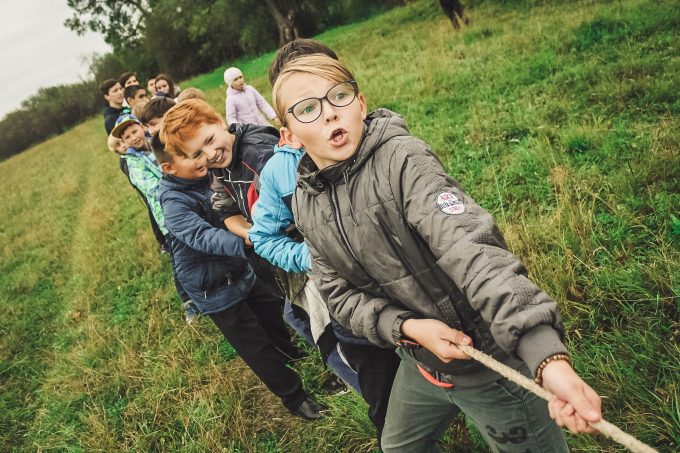
I don’t call this a true group lesson as I believe group lessons should be about collaboration.
If the students are working with headphones most of the time, then this is essentially supervised independent practice combined with mini-private lessons. While this might work OK for older students, it’s just not realistic for preschool-aged students.
The only benefit I see is that the studio can fit more kids in a class and make more money…and if that’s your primary motivator I think you should be in a different business.
Get the Equipment You Need
Even if you’re running group preschool piano classes, you don’t necessarily need a bunch of equipment. There are a few essentials though that you might not have needed for your older students.
Adjustable Benches
You 100% need a way to adjust the height of your bench if you’re going to teach lots of young kiddos.
I absolutely love my current bench which is an ‘Andexinger Lift-o-matic’. I have the super long one which you can find on Thomann here. (For those in the US this one on Amazon looks similar.)
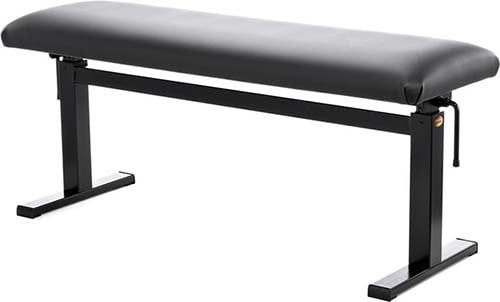 My older bench (which I still use for my digital piano) was the kind that rolls up and down with knobs at the side, like this one on Amazon. These work perfectly well and are absolutely the more affordable option but the hydraulic lift adjusts so much more quickly and easily which I love.
My older bench (which I still use for my digital piano) was the kind that rolls up and down with knobs at the side, like this one on Amazon. These work perfectly well and are absolutely the more affordable option but the hydraulic lift adjusts so much more quickly and easily which I love.
You can of course improvise your own solution using foam mats or carpet squares or towels if you can’t afford a new bench right now. Please make sure that it is super sturdy and secure. There’s nothing worse than a teeter-tottering bench, especially for a wiggly preschooler!
Footstools and Pedal Extenders
Have somewhere to plant your feet is just as important as being at the right height. (If you don’t believe just try playing piano with dangling feet. It is not easy.)
The pedal extender I have is called the ‘A-leg-gro-ped’ (haha, get it?!) and it comes from a UK company. If you’re over the other side of the Atlantic then the one I hear recommended most often is the PE-2 which you can buy here.
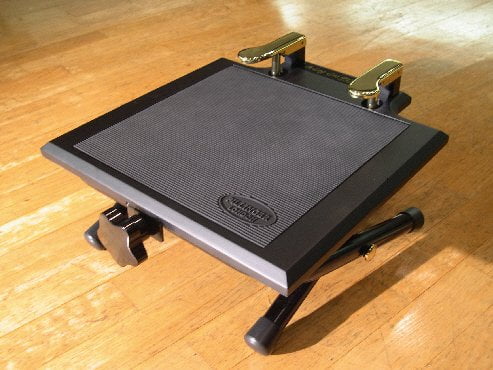 I highly recommend investing in a pedal extender once you’re sure you want to teach preschoolers over the long-term. But in the meantime, you can get a simple footstool to keep them grounded.
I highly recommend investing in a pedal extender once you’re sure you want to teach preschoolers over the long-term. But in the meantime, you can get a simple footstool to keep them grounded.
My favourite for 3 and 4 year olds is the Bolmen from IKEA because it’s nice and high. If you have storage boxes around that are the right height just flip ’em over and use those. It doesn’t need to be fancy just steady.
Other fun stuff
A set of percussion instruments is a great thing to have on hand for preschool piano lessons. You can pick up a mixed set like these on Amazon or in your local music shop.
Two other things that come in very handy are Deskbells and Boomwhackers. These provide a great stepping stone towards playing at the piano.
Follow a Preschool Piano Curriculum
One thing’s for certain when you’re teaching piano to preschool students: you need a plan.
Trust me, preschoolers move quickly. If you’re not on the ball with what you’re doing and following a clear structure, they will not wait for you. They will make their own plan…and you don’t want that chaos!
Curricula for Group Preschool Piano
Of course, I’m biased since I have my own group preschool piano curriculum called Mini Musicians.
This is designed to be a no to low practice plan for the first 2 years of study. It incorporates creativity and games throughout the lessons, requires only one piano and is perfect for groups of 4–8 students.
If that sounds like a good fit for you then all you need to do to access the full plans is to become a member of Vibrant Music Teaching.
If Mini Musicians doesn’t sound quite right for your needs, then there are tons of other options out there. Just do your research and make sure you’re comfortable with any ongoing licensing fees and that it will work out for you financially in the long-run. (There are no licensing fees for Mini Musicians, just the super-affordable monthly or annual membership costs.)
Curricula for One-on-One Preschool Piano
There are a few method books out there specifically for preschoolers:
- Dogs and Birds
- Wunderkeys
- My First Piano Adventures (really for ages 5+)
My preferred approach, however, is to combine Piano Safari with my Tiny Finger Takeoff curriculum.
Piano Safari is not specifically designed for preschoolers. But because of their use of rote pieces and their steadily-paced approach to reading music I find it adapts well and I can slow it down and reinforce concepts as much as I need to with Tiny Finger Takeoff activities.
Get Ready to Move, Sing and PLAY
No matter what method or curriculum you end up using, promise me one thing, will you? Bring playfulness into all how you teach piano to preschoolers.
Preschool-aged children are meant to move about and have fun. Get them up off the bench using activities like stepping and skipping games and keyboard geography activities and make sure they have creative opportunities by bringing improvisation into your preschool piano lessons.
For more ideas about how to bring playfulness and exploration into your preschool piano teaching, including improv activities, visit my central hub on all-things-preschool-piano.
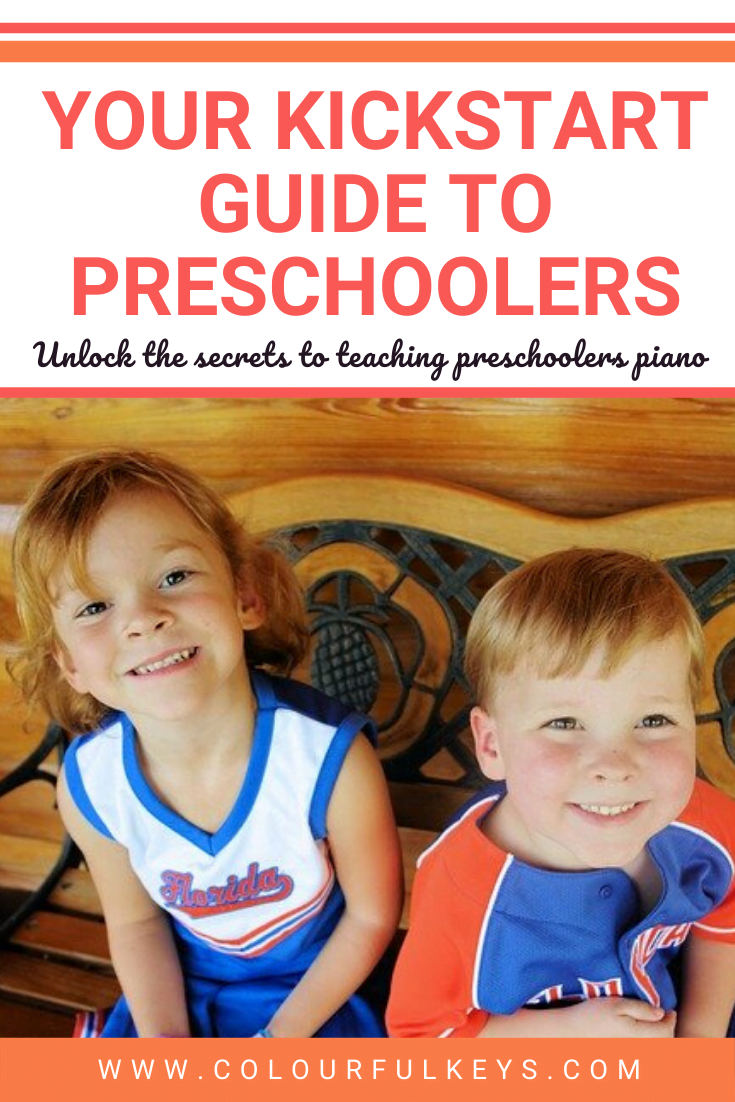
Nicola, Would love to attend the improv session next tuesday but am already committed to a large zoom meeting.
Karen Thickstun shared your survey data from last year with me. Your report is superb. Presentation is engaging and kept my interest throughout. When I start teaching again, hopefully in fall of 2021, maybe I can get involved with your survey as well. I noticed you have many state-side teachers involved. I was not aware that Colourful Keys was such a large program. I would love to read through many of your blogs as I scanned titles. What is your fee?
I look forward to hearing from you. Please give Tim my best.
Martha Hilley, NCTM
President, Music Teachers National Association
Professor Emeritus, Butler School of Music, College of Fine Arts
Distinguished Teaching Professor Emeritus, The University of Texas at Austin
Hi Martha! Great to hear from you!
Thank you for your kind words about the report. We’re aiming to make it bigger and better every year as I believe it’s something our industry really needs.
Colourful Keys, the blog, is totally free. Our membership community is at vibrantmusicteaching.com and that’s where we have our games library and courses.
Will pass on your best wishes to Tim and hope to see you soon!